Friday, Apr 28, 2017
From the Wilder Side of Oakland County on the Oakland County Blog
By Jonathan Schechter - he is the Nature Education Writer for Oakland County Government and blogs weekly about nature's way, trails, and wildlife on the Wilder Side of Oakland County.
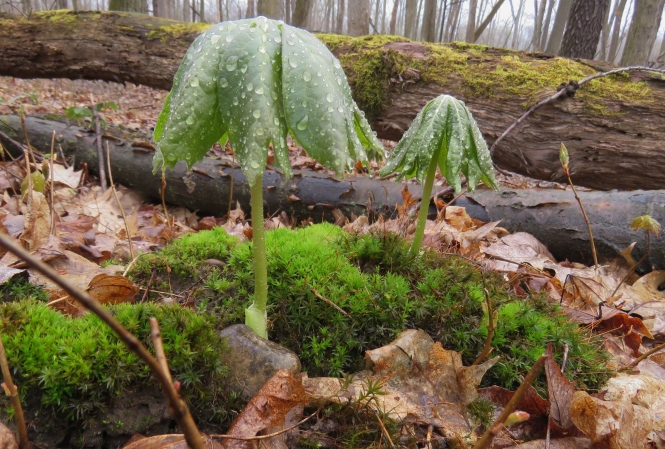
If you are looking for place to deepen your awareness of nature and embrace her presence, the Timberland Swamp Nature Sanctuary in the wilds of Springfield Township might just be the place.

The sun had been up for a few hours, but still struggling to break through the overcast sky, when we arrived. A gentle rain, devoid of the drama and power of a sudden spring thunderstorm, was fading. The first few hundred feet of primitive trail was mostly a squishy carpet of moss, and then the rich muck that clung to our boots marked our passage on a narrow creaky boardwalk that nature struggled to reclaim. An ethereal stillness hung over the swamp, interrupted only by the drumming of Pileated Woodpecker, and then the melodious melody of a pair of Barred Owls. I felt a bit like an explorer stumbling into a hidden habitat that was mysteriously wild, where humans are just passing intruders. We were.

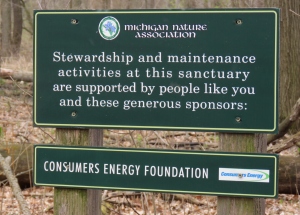
The Timberland Swamp Nature Sanctuary is the largest sanctuary in southeast Michigan managed by the Michigan Nature Association. According to their website, "This 245-acre area has remained largely undisturbed since the surrounding land was farmed in the early 19th century. From the mid-1800s until MNA's acquisition, the swamp provided timber for local settlers and farmers, with former logging traits still evident into the early 1900s. The sanctuary is adjacent to Indian Springs Metropark, and together they protect more than 2,000 acres of sensitive habitat and green space."

Two choices awaited our mid-April rainy day exploration. Both would have been perfect. One would have been to just sit against a tree and absorb the serenity of the swamp. The other choice was to follow the words of William Wordsworth, "Come forth into the light of things. Let Nature be your teacher." We did both. We wandered the trails slowly, while consciously seeking out nature's secrets - and stopping at trees to sit, lean and listen. We were well rewarded.
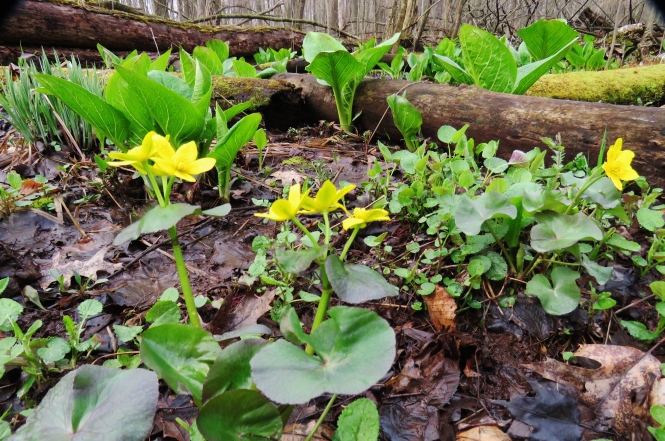
Oakland County is blessed with a diverse array of forest habitats, and some of those habitats are hardwood swamps. The Timberland Swamp Nature Sanctuary has fascinating forest forensic stories to share. Some forest stories are difficult to interpret, while others are open books of natural history for those that take the time to explore. To understand and appreciate the habitat of Timberland Swamp one must take note of the thousands of fallen trees. They fell for different reasons. Knowing the reasons will enrich your trek along the three miles of the narrow meandering trail, a habitat that includes log-crawling slugs, hidden salamanders, numerous species of birds, eastern massasauga rattlesnakes, mink, deer, fox, coyotes, ferns and an impressive array of wet woodland wildflowers.



Blowdowns are downed trees that were uprooted by winds strong enough to topple a living tree. When the cataclysmic fall occurs, a gaping hole is left where their root mat was ripped from the earth. Deadfalls were already dead trees that fell in a wind. Many of the deadfalls in this swamp are ash trees, killed by emerald ash borers. How does one tell the difference between a blowdown and a deadfall? It's fairly easy. A fresh blowdown usually has bark remaining all around the trunk and a large hole in the ground is present where the base of the tree was located. Deadfalls have little bark left, and a close observer of nature notices another clue, the position of fungi. The fungi on the tree bark of a fresh deadfall is at a 90 degree angle to the ground, while blowdowns grow fungi that are level with the plane of the ground.

The habitat of Timberland Swamp Nature Sanctuary is nearly flat and encompass small streams, vernal pools, wooded wetlands and of course "swampy" lands. In some locations there is not a clear defining line between what is land and what is water. The wetter parts of the terrain have red maple, silver maple, white ash, black ash, basswood and yellow birch trees. A few feet of elevation led to beech-maple woods, with black cherry, shagbark hickory and mature red oaks mixed in. A small meadow clearing in the woods brought a surprise encounter; a Sandhill Crane that cautiously stalked away from us. Wildflowers were just beginning to bloom during our trek, with delicate spring beauties edging much of the trail, and marsh marigolds adding brilliant splashes of yellow amidst the thick carpets of skunk cabbage. Trillium bloom is just around the corner, and May Apples will flower shortly. May Apples have an umbrella-like shape as they emerge from the soil an on our magical moist morning hike one could almost imagine elves hiding underneath the leaves to stay dry.


Three hours was not nearly enough time to explore the trailside wonders of this amazing swamp on the Wilder Side of Oakland County, but four encounters deserve more mention.
May Apples
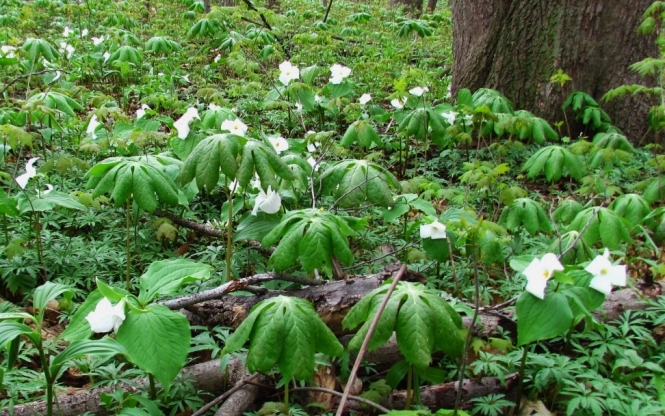
I consulted my friend Sakoieta Widrick, a Mohawk elder from the Wolf Clan and Instructor of Iroquoian Culture and a Mohawk Language Specialist for his take on the May Apple. Here's what he shared. "May Apple, also known as a Ground Lemon or Wild Mandrake, was used by the Mohawks and other Iroquois Nations as a medicine to help deal with illnesses and keep the body functioning on a healthy level. It was used for treating infections in animals, used as a laxative, as a medicine for boils, and also as a corn medicine. In its usage with corn, the corn seeds were soaked in the roots of the May Apple to protect the sprouting corn from birds and worms. Then when finished the plant parts were returned to the woods again and thanks was given for the plant helping us as was instructed by the Creator for it to do so."
Wood Ducks

The Wood Duck is a stunningly beautiful bird. The males are iridescent chestnut and green while the more subdued, yet elegant females, have a distinctive profile and delicate white pattern around the eye. They nest inside tree cavities making wooded swamps, such as Timberland Swamp, a five-star habitat. They also have strong claws on the edge of their webbed feet enabling them to cling to tree branches. Ten minutes of patience during our trek enabled us to capture an image of a female wood duck outside of her nesting cavity.
Red-Backed Salamander

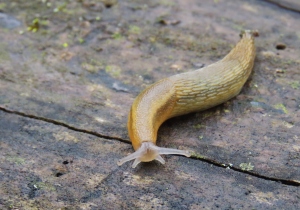
The Eastern Red-Backed Salamander is one of the most active, and without doubt, smallest predator of the preserve. Their presence indicated a healthy ecosystem. These tiny creatures thrive in damp habitat under decaying logs and leaves and hunt invertebrates of all sorts, including snails, slugs, and spiders. They are the only lungless Michigan salamander and absorb oxygen through their skin and then directly into the bloodstream. Their skin must be moist at all times. Timberland Swamp insures that critical need.
Blowdown Microhabitats
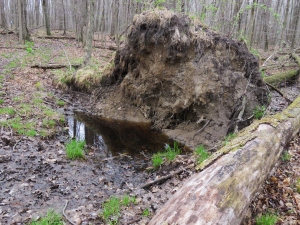

Many of the water-filled holes created by roots ripped out by blowdown treefalls provide habitat for small species, including amphibians. One of those trailside microhabitats had a frog almost hidden under a floating leaf, perhaps waiting for a mate, or a bug to land. A return trip to these blowdown habitat holes tempts, perhaps for the frog, certainly for me.

